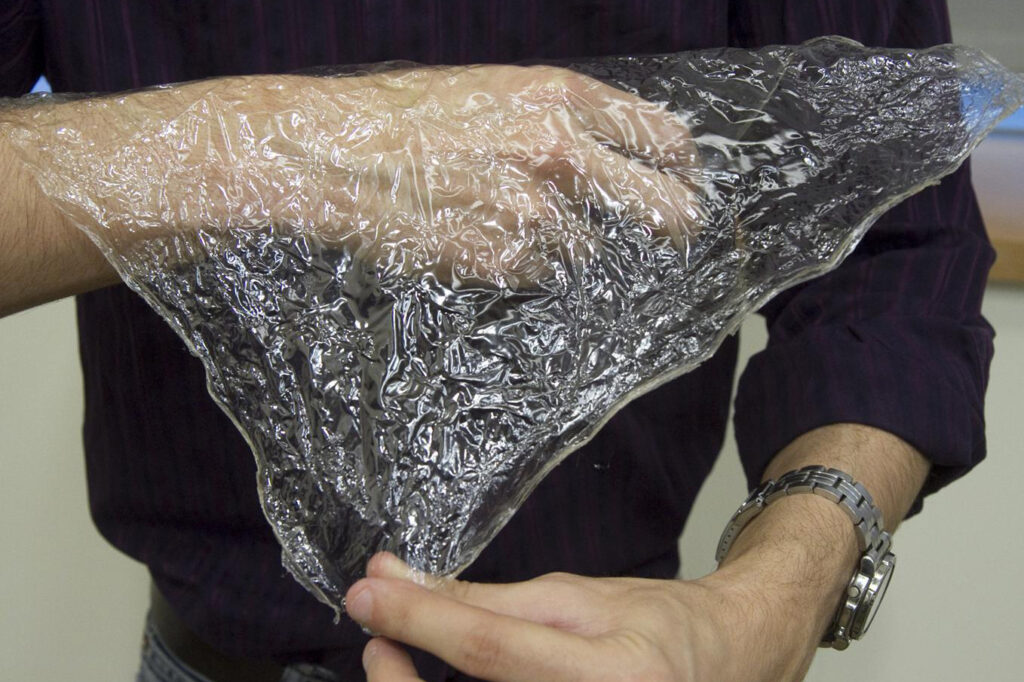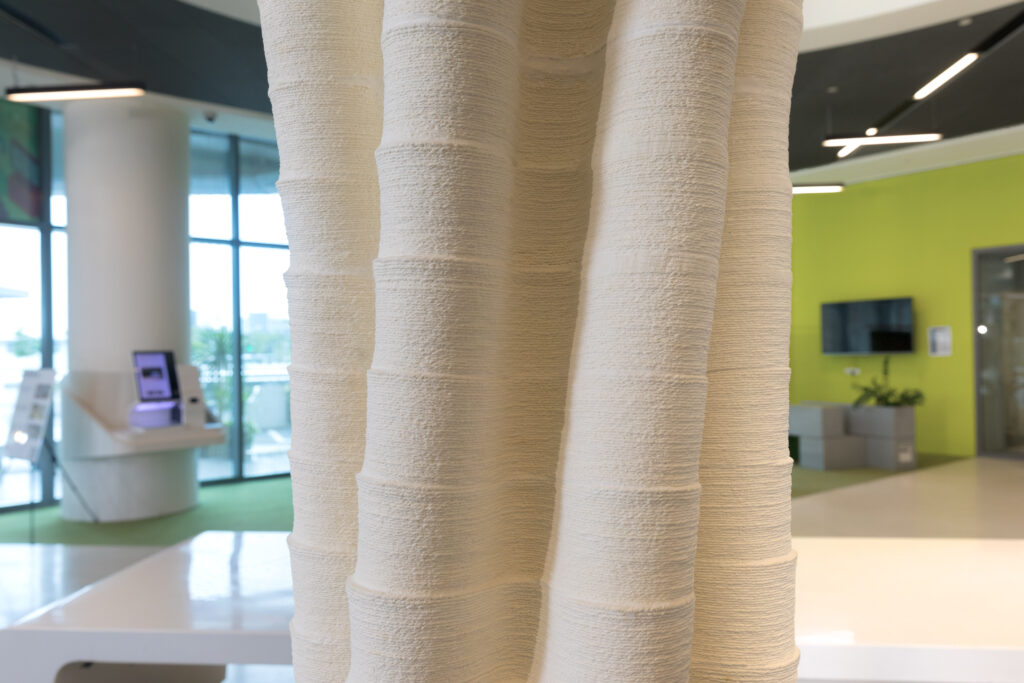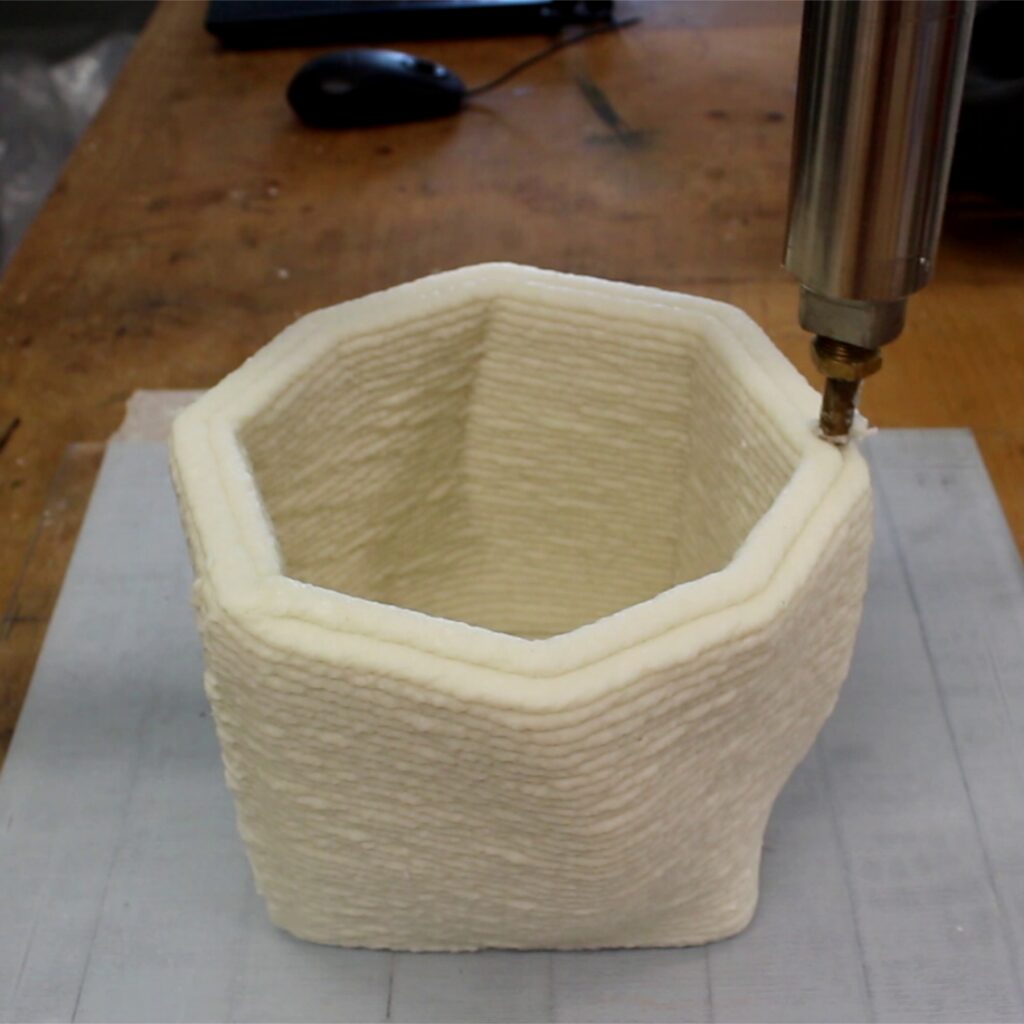 I can’t remember when a startup so excited me as Chitonous does. This one is a long shot but it could fundamentally change how we design and consume materials for manufacturing. Rather than create new exotic bioplastics and recycling systems for them, Chitonous wants to let us use abundant materials in nature to 3D print the future. By using low cost locally available and locally produced materials the firm wants to create a new local-centric environmentally friendly manufacturing paradigm. By emphasizing locally created natural materials that work in conjunction with the natural world they may just have come up with a more efficient way for us to manufacturing. Its an incredibly ambitious plan but the Phd heavy team has the scientific chops to back it up and for years now has been working on making working 3D printing materials from natural sources. I love Chitonous’ ambition, concept and technology and so we interviewed their charismatic co-founder Javier G. Fernandez. Javier leads the Singapore based startup but is also an assistant professor at Singapore University of Technology. Previously he was a research fellow at Harvard, at the Wyss Institute and at MIT. Javier has a Phd in Nanobiotechnology and Masters in both Physics and Nanotechnology.
I can’t remember when a startup so excited me as Chitonous does. This one is a long shot but it could fundamentally change how we design and consume materials for manufacturing. Rather than create new exotic bioplastics and recycling systems for them, Chitonous wants to let us use abundant materials in nature to 3D print the future. By using low cost locally available and locally produced materials the firm wants to create a new local-centric environmentally friendly manufacturing paradigm. By emphasizing locally created natural materials that work in conjunction with the natural world they may just have come up with a more efficient way for us to manufacturing. Its an incredibly ambitious plan but the Phd heavy team has the scientific chops to back it up and for years now has been working on making working 3D printing materials from natural sources. I love Chitonous’ ambition, concept and technology and so we interviewed their charismatic co-founder Javier G. Fernandez. Javier leads the Singapore based startup but is also an assistant professor at Singapore University of Technology. Previously he was a research fellow at Harvard, at the Wyss Institute and at MIT. Javier has a Phd in Nanobiotechnology and Masters in both Physics and Nanotechnology.

What is Chitonous?
Chitonous (pronounced kait-o-nous) is a company focused on large scale production of bioinspired materials and manufacturing technologies. Its leading technology FLAM 3D, is based on the two most ubiquitous biological polymers on earth and enables the rapid production of objects of scales ranging from half millimeter to several meters. The uniqueness of this technology respect other so-called biodegradable materials is that the biological molecules are never chemically modified but “arranged” in the same configuration they evolved to follow in natural systems. As a result we are able to replicate the outstanding properties of biological materials while they keep seamless ecological integration. This is the only free form technology fully integrated in ALL the ecological cycles of earth, without the need of human intervention or recovery.

What materials do you use?
The main components we use are cellulose (the most abundant and broadly distributed biological molecule) and chitin (the most abundant one). To give a magnitude of what ubiquitous means in terms of natural molecules: Earth naturally produces in one year the amount of chitin to supply more than 300 years of plastic production at the current rate. And all this material is produced and degraded in continuous cycle everywhere in the world, from insects and crustaceans, to fungi and even recently has been discovered in fish.

Why those materials?
Because the are the two most abundant and broadly distributed. If you combine a freeform technology (such as 3D printing) with materials that are everywhere in the world, you are setting the ground for a paradigm shift, where the need of transport materials and products completely disappear. We can fabricate anything anywhere. Our technology has been called “the missing piece for circular economy” for a good reason. We are going much beyond the current concept of circular economy, by introducing a generalizable technology to develop regional circular economies, where materials and products are obtained, manufactured, and degraded in closed regional areas, with minimal transport. And everything seamlessly integrated in the ecology of the region. The fact that these two main ingredients are produced by such disparate organism and are abundant in every ecosystem enable for first time to match general manufacture to the surrounding ecosystem.

How does it work?
We have developed our technology following the concepts of structural biological materials. Nature is able to produce extraordinary materials; the strength of spider silk, the impact resistance of nacre or the lightness/vibration absorption of balsa wood are outstanding compared to the best performing synthetic counterparts. However what is even more extraordinary is the conditions in which those materials are produced. Nature doesn’t have the luxury to use very rare ingredients, to move components all around the world, or to use enormous sources of energy as we do with plastics and metals. Biological systems use the most abundant components, most of them with negligible mechanical properties, and almost no energy to produce these mechanically outstanding materials. The trick of nature is the complex designs in which those components are arranged in what is called a hierarchical designs.
In 2012 we demonstrated for first time that linking natural molecules with the design they evolved to follow enables the reproduction of those extraordinary mechanical properties for engineering applications. That first material, named Shrilk, supposed a change of paradigm. It not only gave the key to a new family of materials for manufacture, it also set the ground for the development of technologies fully integrated in the ecology of earth. 3 years later we developed the general application of that material, called Fungus Like Adhesive Materials (FLAMs).
FLAMS are developed as a technology for manufacture and a material, in parallel. They can be molded, 3D printed or processed as if they were wood (sanding, drilling, carved…). One of our first demonstration was the 3D printing of a 1.2m wind turbine blade, which was produced entirely with FLAM using a combination of traditional and new techniques. A year later we produced the Hydra, a 5m tall structure that to date is the largest biological object ever printed in the whole world.

What kinds of things can you make with your materials?
We currently are printing -using the same system and material- objects ranging from 0.5mm to 5 meters. It is important to note that this technology has been fully developed in the last 2.5 years, from scratch, and currently we can look in the eye to the most advanced systems for additive manufacture with synthetic polymers. Theoretically we don’t have any limit, those are the limits we have explored due to the applications we are considering. In the future we will broad them if we find any application needing better resolution or larger scale.

What do you hope to achieve in five years?
Chitonous has been born to change the world, and finally all the pieces are in place. We are the only company and technology that can look in the eye to the current paradigm centered in plastic manufacture in terms of cost, versatility and scalability, and we are fully integrated in the ecology of earth, which means not only a revolution on the transport of objects and materials, but also on the cost of waste management for companies and municipalities. We are collaborating with some of the largest companies in the world in fields form automotive, to oil and gas, to electronics. What is very important to remark is that most of these agreements have been motivated by the possibilities that our technology enables in their respective fields and not because the enviromental benefits. We believe this is important because we expect our approach to revolutionize the society and the economy as stone, bronze, iron or plastic did in the past: the appearing of a new material that enables a qualitative leap on the technological development, resulting on a change on the society and the economy. And in this case a development around bioinspired manufacture involves the transition to a sustainable society.

Whats the difference between your materials and PLA for example?
PLA, as most so-called biodegradable plastics are based on the paradigm imposed by plastic manufacture. While they are from biological origin, the need to transform them into a material that can be directly introduced in the existing manufacturing technology, result in a material that diverges form the natural origin. As a result, every step on the modification of the material to make it similar to the synthetic polymers is a step away from nature. The result is a material that, while started being natural, transformed in something easy to manufacture but that nature can’t understand. In the case of PLA degradation only happen in very specific conditions of temperature and microorganisms, therefore it needs to be recover and brought to a specialized facility to be degraded. This is something generally misunderstood by most people, who believe that a piece of PLA in your backyard will compost naturally. Actually PLA will last in the environment a time similar to many “non-biodegradable” synthetic plastics. Actually in many application, if recovery is ensured, actually other plastics with less carbon foot print might be a greener choice. The important aspect here is the recovery, which is the problem of plastic. Recovery is not happening, it is the highest expense of municipalities all around the world, and is becoming even more unaffordable as our waste becomes more complex and abundant.
Our concept is the opposite. Nature only understand natural materials, therefore the solution to our unsustainable development won’t come from the invention of a new material, but from the control of biological materials that have been around for millions of years. In our approach we never change the natural molecule, the planet is full of examples of biological materials with enormous potential for engineering, so we don’t need new ones, we need to be able to use them as nature does. We first understand how nature fabricates and then we replicate those materials with the same components. We cant rely on exiting technology, but to develop technology with the principles of biology. The result are materials that are perfectly integrated in the ecology of earth and are produced and degraded without the need of human intervention (i.e. no recovery is needed). We are just including a new step in the life of a material, between its natural synthesis and degradation, by transforming it in an object.
So we could just leave parts made with your materials in nature?
Technically we are not “leaving” them in nature since they never left. But yes, since we never modified the biological molecules, these objects are part of nature, so in the eyes of nature they are no different to a piece of wood. Human intervention is completely unnecessary, they will fully degrade and integrate in every ecosystem of earth, without the need to recover or treat them.
Are they all compostable?
100% in the full sense of that word. Where you see a lot of different 3D printed objects, nature sees a mushroom.
How do you obtain your materials?
We currently are obtaining them as raw materials (cellulose from green plants and chitin from fishing industry) or from urban waste (food and paper waste).
What types of applications do you see?
Our current material is similar to a (very) high density polyurethane foam, and ideal to make large objects. We have chosen to move first into that area because synthetic polymers struggle to fill that space, while we don’t have any limitation of size and our cost is 20 times cheaper. We present an enormous opportunity for manufacturers of objects of a few meters, such as car parts, furniture, construction, or machinery. The objective is to expand to general scope in the next few years.
What are the limitations?
We are a new technology and as such largely misunderstood. For most of the people is hard to believe that we have a technology that can look in the eye to plastic manufacture and at the same time be fully sustainable, to the point that can trigger a paradigm shift in the whole manufacturing ecosystem. For everybody these doubts end once they touch the material and test its properties.
What would the costs per kilo be?
The current cost of FLAM is 1.6 $/Kg, but we expect this cost to drop significantly when we remove transportation from the equation. That cost is similar to commodity plastics, but is 10-20 times cheaper than the plastic filament. Just analyze that sentence: we just made 3D printing 10 to 20 times cheaper. This is the first technology in the history of humanity that can look in the eye to plastic manufacture in terms of cost, versatility and scalability. And it is fully integrated in the ecology of earth.
What kinds of partners do you seek?
At this point most our conversations are with big companies that see in our technology an enabling technology to transform and bring their business to a new level. We got a lot of requests from people with interest in substituting non sustainable materials in niche applications. Unfortunately our objective right now is to engage with major partners that can help to scale the technology as fast as possible. We are already have the first pilot plant in the works, so we are looking for investors that understand and resonate with our vision, to tackle the problem of sustainability offering a new paradigm in manufacture, and enabling the transition to sustainable societies and economies as a result of our transition to a new technological age based on biological materials and technologies.
Subscribe to Our Email Newsletter
Stay up-to-date on all the latest news from the 3D printing industry and receive information and offers from third party vendors.
You May Also Like
3D Printing Unpeeled: New Arkema Material for HP, Saddle and Macro MEMS
A new Arkema material for MJF is said to reduce costs per part by up to 25% and have an 85% reusability ratio. HP 3D HR PA 12 S has been...
3D Printing News Briefs, January 20, 2024: FDM, LPBF, Underwater 3D Printer, Racing, & More
We’re starting off with a process certification in today’s 3D Printing News Briefs, and then moving on to research about solute trapping, laser powder bed fusion, and then moving on...
3D Printing Webinar and Event Roundup: December 3, 2023
We’ve got plenty of events and webinars coming up for you this week! Quickparts is having a Manufacturing Roadshow, America Makes is holding a Member Town Hall, Stratafest makes two...
Formnext 2023 Day Three: Slam Dunk
I’m high—high on trade show. I’ve met numerous new faces and reconnected with old friends, creating an absolutely wonderful atmosphere. The excitement is palpable over several emerging developments. The high...































